In this article, Canstar Blue walks you through all the important sections of your electricity bill and we explain how this information can help you spend less on energy.
Let’s talk about power bill. It might not be your favourite topic, but knowing how to read and extract information from your bill is crucial to understanding how you can save on electricity.
After receiving an electricity bill, most of us simply look at what we owe and begrudgingly pay up. But there’s plenty of useful information on your bill that can help you save, so it’s worth taking the time to read your bills carefully.
Below we dissect each component of your power bill in detail to help you better understand your costs and potential savings.
On this page:
Here are some sponsored deals from the retailers on our database that include a link to the retailer’s website for further details. These are products from referral partners†. These costs are based on the Ausgrid energy network in Sydney but prices may vary depending on your circumstances. This comparison assumes general energy usage of 3900kWh/year for a residential customer on a single rate tariff. Please use our comparison tool for a specific comparison in your area and to see other products in our database that may be available. Our database may not cover all deals in your area. As always, check all details of any plan directly with the retailer before making a purchase decision.
|
21% Less than reference price |
$1,435 Price/year (estimated) |
Go to Site |
Here are some sponsored deals from the retailers on our database that include a link to the retailer’s website for further details. These are products from referral partners†. These costs are based on the Citipower network in Melbourne but prices may vary depending on your circumstances. This comparison assumes general energy usage of 4000kWh/year for a residential customer on a single rate tariff. Please use our comparison tool for a specific comparison in your area and to see other products in our database that may be available. Our database may not cover all deals in your area. As always, check all details of any plan directly with the retailer before making a purchase decision.
 |
|
10% Less than VDO |
$1,304 Price/year (estimated) |
Go to Site |
Here are some sponsored deals from the retailers on our database that include a link to the retailer’s website for further details. These are products from our referral partners†. These costs are based on the Energex network in Brisbane but prices may vary depending on your circumstances. This comparison assumes general energy usage of 4600kWh/year for a residential customer on a single rate tariff. Please use our comparison tool for a specific comparison in your area and to see other products in our database that may be available. Our database may not cover all deals in your area. As always, check all details of any plan directly with the retailer before making a purchase decision.
 |
|
9% Less than reference price |
$1,888 Price/year (estimated) |
Go to Site |
Here are some sponsored deals from the retailers on our database that include a link to the retailer’s website for further details. These are products from our referral partners†. These costs are based on the SA Power network in Adelaide but prices may vary depending on your circumstances. This comparison assumes general energy usage of 4011kWh/year for a residential customer on a single rate tariff. Please use our comparison tool for a specific comparison in your area and to see other products in our database that may be available. Our database may not cover all deals in your area. As always, check all details of any plan directly with the retailer before making a purchase decision.
 |
|
9% Less than reference price |
$2,036 Price/year (estimated) |
Go to Site |
How to read an electricity bill
Electricity bills are issued by your energy retailer, and detail how much money you owe to your provider based on your energy usage costs for the month or quarter, depending on your billing cycle.
As part of the Better Bills Guideline, which came into effect on September 30, 2023, all energy companies are required to show specific details on electricity and gas bills to help consumers understand their usage and costs. Some of these key requirements include simplified language, easy-to-understand design and best offer messaging.
These improvements are typically reflected in the following sections on your bill: account information, electricity cost summary, best offer messaging, energy usage summary, plan information, payment options and metering details.
To explain these parts of your bill, we’ll be using a sample bill from Alinta Energy – an electricity and gas retailer that operates across New South Wales, Victoria, South East Queensland, South Australia and Western Australia.
Account information
The first part of your bill summarises all the relevant information about your account. You can see that it includes information such as the issue date for this bill, your account details, your National Meter Identifier (NMI), and how to contact Alinta Energy for customer service, as well as your network distributor for faults and emergencies.
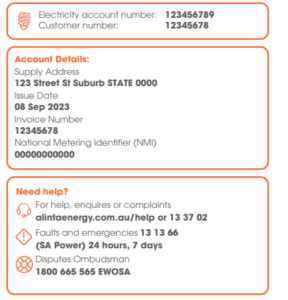
Electricity cost summary
This summarises the total amount owing on your latest bill and the payment due date. The bill in this example is for $47.12, with a due date of September 29, 2023.
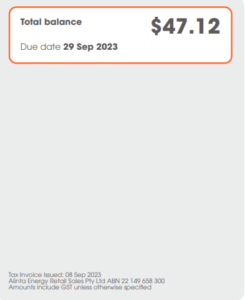
Best offer messaging
This section of the bill highlights to customers whether they could be saving on their energy bill by switching to their retailer’s deemed ‘best offer’.
This best offer is determined using customers’ past usage, typically over a 12-month period. This information is a legal requirement on bills, enforced by the Australian Energy Regulator (AER) and must also include details on how to switch to this plan if customers wish to be on the better deal.
In the example below, the customer could be saving $157.44 a year by switching from their current offer to Alinta Energy’s best offer for them.
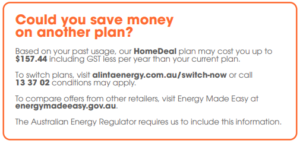
Payment options
This section is usually situated at the footer of the first page of your bill and is fairly self-explanatory.
At the bottom right, you have a recap of what’s owed on this bill.
Above, you’ll be greeted by the payment options you can use to settle your bill, such as direct debit, paying in person at the post office, mailing your payment, and paying using a credit card or BPAY by phone or the internet.
Important information
Also known as ‘Assistance and support services’, this section generally offers information on how to best access the following support schemes:
- Payment assistance: the National Energy Retail Law requires all providers to offer payment and support plans for customers facing financial hardship.
- Interpreter service: customers who need translation assistance can access this service via the provided hotline.
- National Relay Service (NRS): the NRS offers the hearing and speech-impaired phone support services that interpret what is said or typed.
In this example, this section also includes supporting information on:
- Concession eligibility
- Energy efficiency guide
- Tips on connecting electricity to a new home after moving
- How to set up a direct debit.
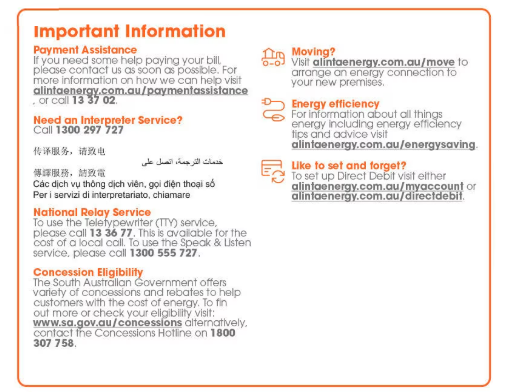
Plan information
In this section, you will find the key details regarding your plan such as its name, features and any additional benefits, such as pay-on-time or direct debit discounts.
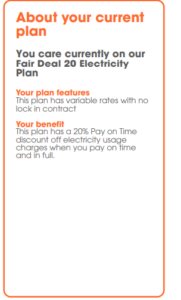
Metering details
This section generally contains the finer details that many of us would likely skim over. Nevertheless, these nuggets of information could help you reduce your energy usage. In this section of your bill, you’ll typically find the following:
- Bill credits: the top row displays the credited amount you are entitled to off your bill. Depending on your plan’s terms and conditions, bill credits can be an ongoing or one-off incentive.
- Usage charge: the first column shows the electricity usage charges. This bill shows that the customer has been charged for peak, off-peak and shoulder rates.
- Supply charge: the supply charge is a daily fixed fee that applies regardless of how much electricity you use, if any.
- Reading type: this refers to whether your energy usage was read off your meter, or whether it was estimated – in this example, it was read.
- Quantity: the total usage taken from the meter read which has been used to calculate the final costs of the bill.
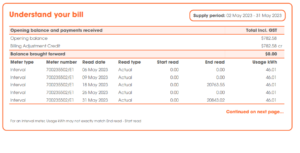
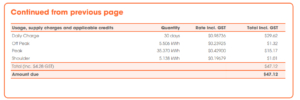
Charging periods
This section offers key insights into how much energy costs at different times of the day, split into each tariff type.
Knowing how electricity is being charged at different intervals can help you decide if you’re on the most cost-effective tariff or if there’s any room to cut down on energy usage during peak periods.
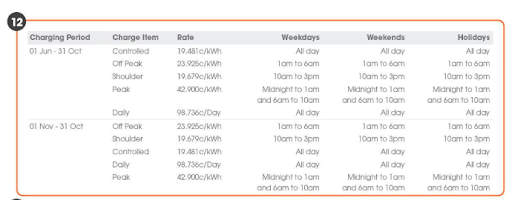
Energy usage summary
This part of the bill breaks down your electricity usage, illustrating your energy habits and how your usage compares to households in your area. This is the section of the power bill that most of us would be familiar with.
To the left, you can see a graph depicting your total monthly electricity usage, as well as your current daily average usage compared to the same time from last year.
On the right, you’ll be able to see your average daily cost, total greenhouse gas emissions and electricity usage compared to other households in your area. This information helps you to visualise patterns or trends in your electricity usage.

How to read electricity bill terms
Here is a guide to common phrases found on most energy bills:
- Peak hours: the specific times may vary depending on the plan, location, and/or network. However, peak times are typically Monday to Friday, from 7am to 11am and 5pm to 9pm.
- Tariffs: the rate at which you are charged for electricity usually falls into two categories: single rate and time-of-use.
- Single rate: you are charged the same rate throughout the entire day.
- Time-of-use: you are charged different rates based on usage during peak and off-peak hours.
- Average cost per day: the average daily cost for electricity usage, which includes a daily supply charge.
- Average daily usage: the amount of energy you use each day.
- kWh: short for Kilowatt-hour, this is the unit used to measure your electricity usage.
Looking for a better electricity deal?
The table below shows a selection of some of the cheapest power plans on our database in each state.
Here are some of the cheapest published deals from the retailers on our database that include a link to the retailer’s website for further details. These are products from referral partners†. These costs are based on the Ausgrid network in Sydney but prices may vary depending on your circumstances. This comparison assumes general energy usage of 3900kWh/year for a residential customer on a single rate tariff. Please use our comparison tool for a specific comparison in your area. Our database may not cover all deals in your area. As always, check all details of any plan directly with the retailer before making a purchase decision.
Here are some of the cheapest published deals from the retailers on our database that include a link to the retailer’s website for further details. These are products from referral partners†. These costs are based on the Citipower network in Melbourne but prices may vary depending on your circumstances. This comparison assumes general energy usage of 4000kWh/year for a residential customer on a single rate tariff. Please use our comparison tool for a specific comparison in your area. Our database may not cover all deals in your area. As always, check all details of any plan directly with the retailer before making a purchase decision.
Here are some of the cheapest published deals from the retailers on our database that include a link to the retailer’s website for further details. These are products from referral partners†. These costs are based on the Energex network in Brisbane but prices may vary depending on your circumstances. This comparison assumes general energy usage of 4600kWh/year for a residential customer on a single rate tariff. Please use our comparison tool for a specific comparison in your area. Our database may not cover all deals in your area. As always, check all details of any plan directly with the retailer before making a purchase decision.
Here are some of the cheapest published deals from the retailers on our database that include a link to the retailer’s website for further details. These are products from referral partners†. These costs are based on the SA Power network in Adelaide but prices may vary depending on your circumstances. This comparison assumes general energy usage of 4000kWh/year for a residential customer on a single rate tariff. Please use our comparison tool for a specific comparison in your area. Our database may not cover all deals in your area. As always, check all details of any plan directly with the retailer before making a purchase decision.
How can I reduce my power bill?
Understanding how to read your power bill is only half the battle – the other half is acting on the information you are given.
For example, if you discover you have low electricity usage and a large portion of your bill comprises supply charges, you may need to find a better deal suited to low-use households.
Customers on a time-of-use tariff can also use their electricity bill to pinpoint the hours when they’re using the most electricity, helping identify opportunities to reduce their electricity usage.
Your usage information also reveals if your electricity bills are increasing. If they are, think deeply about what could be causing it and whether there are other ways to reduce your energy usage, such as making your home more energy-efficient.
Paying close attention to the electricity rates you pay will also allow you to catch any sneaky price increases from your provider. Your energy retailer is legally obligated to inform you of any price increases at least five business days beforehand.
After all this, if you’re still struggling with your bill, then perhaps it’s time to explore other options. Check out Canstar Blue’s customer satisfaction ratings or start comparing electricity providers in your area by clicking the button below.
Original reporting by Brendan O’Neill
Image Source: Monkey Business Images/Shutterstock, Alinta Energy website
Frequently asked questions
Even if you pay for gas and electricity with the same provider, you’ll still receive two different bills. So are gas bills any different from electricity bills? Not really. Your gas bill should be virtually identical to your electricity bill, with two notable differences:
- Natural gas is measured in megajoules (MJ), so instead of seeing your electricity usage denoted in kilowatts per hour (kWh), you’ll see your gas usage measured in MJ.
- Your gas distribution network will be different from your electricity distribution network, so don’t worry if you see a different company name.
If you believe there has been a mistake with your electricity bill, your first port of call should be your energy provider. Your energy retailer is best qualified to address, investigate and resolve any concerns or potential errors.
If you haven’t heard from your providers or you’re not fully satisfied with their support, you can contact the Energy Ombudsman.
Click here for a comprehensive guide to disputing an electricity bill.


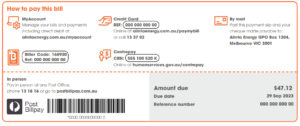

Share this article